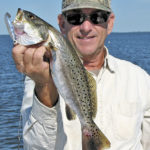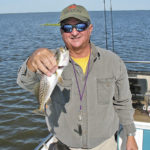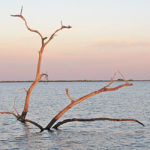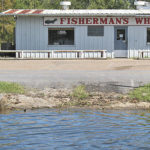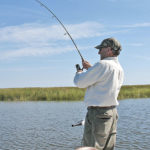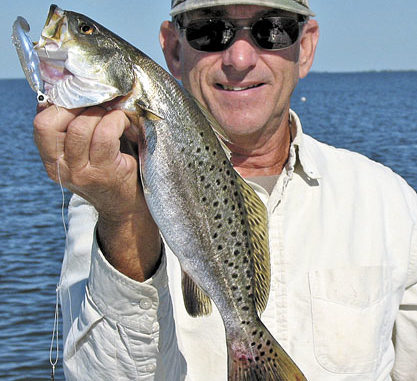
The action is so good in this big Southeast Louisiana lake that you’ll want to smash down your barbs to make all those fish easier to remove.
Lake Salvador is a huge body of water located due south of New Orleans and southeast of the Salvador Wildlife Management Area in St. Charles Parish. At its widest points, it stretches about 16 miles across and 12 miles wide, making it smaller than Lake Pontchartrain but still a sizeable body of water.
Lake Salvador has an average depth of about 6 feet, making it shallower than Pontchartrain as well.
Still, it’s a big lake by almost anybody’s standard, excluding those who ply the waters of Erie, Huron, Superior, Michigan and Ontario, which combined hold 20 percent of the world’s fresh water. Salvador is also mostly a freshwater lake, but it does have enough salinity to attract shrimp and the various species that prey on them.
I recently called on Capt. Gordon Matherne (504-491-3452), who grew up along the banks of Bayou Gauche, a branch off of Bayou Des Allemands. Bayou Gauche has a population of about 2,400, almost all of French descent.
Matherne was raised hunting and fishing throughout the area, and says his family often survived off the catfish and crabs Lake Salvador provided.
I’d never been to Bayou Gauche and wanted to make a trip from the small fishing community. I knew Matherne was the man to call. We launched his 22-foot bay boat at Fisherman’s Wharf in Bayou Gauche, at a steep and narrow backdown on the side of Highway 306. Matherne said it’s the better of the two launch sites on Bayou Gauche, the other at the end of the road.
From there, it was a mere hop to Bayou Des Allemands and then a short ride to the mouth at the western end of Lake Salvador.
“I focus on two main areas when fishing Lake Salvador in November,” Matherne said. “This is the time of year that speckled trout show up in really good numbers along the south side of the lake, roughly from Point Chicot to Bayou Perot. This is where the action is usually best right now for specks and reds.
“But by mid-to-late November, the northeast side really begins to turn on, and it’ll remain good there through January unless the weather gets extremely cold.”
Point Chicot to Bayou Perot
Matherne says the south area is best on any wind from east to south.
“Either way, you’ll have some protection from the wind and waves, and the water doesn’t get all muddied up,” he said. “The worst winds would be west to northeast, which would have the seas pounding that shoreline and muddying up the water. The lake is shallow, so any stiff wind can muddy things up pretty fast. But the south end will be fishable on any east to south wind, and you should be able to find some clean water and fish.”
We passed Point Chicot, and Matherne slowed to idle about 200 yards off the shoreline. He pointed the bow toward an area he called “Bouquet Aaron,” an old Cajun designation for a stretch of shoreline once decorated with trees that once must have resembled a bouquet. He idled the boat to about 150 yards off the bank, and we began fishing.
“You want to idle in from about 200 yards out because of stumps,” Matherne said, “and you can troll closer in or drift and fish. The fish usually hang anywhere from 50 to 150 yards off the shoreline.”
I was casting a glow DOA shrimp under an Old Bayside popping cork, and Matherne had a tandem rig under a snap-on cork. He had a glow beetle on his top rig, and a blue moon Deadly Dudley with a chartreuse tail on the bottom rig. It was the bottom rig that attracted most of the hits over the course of the morning.
“These are my favorite colors for fall fishing — glow and either the blue moon/chartreuse Dudleys or purple/chartreuse beetles. A lot of Lafitte area anglers would add black/chartreuse to their favorite colors,” he said. “And you can fish about 24 to 30 inches under a cork, or just tightline on a ¼-ounce jig.”
One of Matherne’s tactics is to smash the barbs on his jigs.
“Most of the fish we catch this time of year run from about 1 to 1 3/4 pounds,” he said. “We’re talking about 13- to 15-inch trout, and there are often undersized throwbacks in the mix. Without the barb to tear them up, the throwbacks have a higher survival rate. Once you get them in the boat, the fish come off the hooks so much easier without the barb, and as long as you keep the pressure on, you’ll very seldom lose a fish due to the lack of a barb.
“I mostly fish with tandem jigs for two reasons. I find the fish will hit better when you’re dangling twin baits in front of them. Most of the hits come on the back jig. Maybe because it hangs a little deeper, and maybe because the fish see the first bait get away from them and they don’t want to let the second one escape.
“Whether that’s really how they think, I don’t know for sure, but I do know I’ll generally catch more with tandem jigs than those who fish a single jig, even when I’m only bringing in one at a time. And when the bite is really on, I’ll bring them in two at a time.
“Another key to fishing this side of the lake is to look for seagulls. The shrimp show up in good numbers in November, and the gulls will be all over them. When you see birds, creep in quietly and cast under them. You can bet there are either specks or reds under them.
“By December, the gulls have mostly gone, and you’ll want to look for baitfish signs in the water — either schools of mullet or what the Cajuns call sprats (pogies), which get their name from the sound they make on the surface.
“When you see baitfish, fish there. Use the same plastics in glow or purple/chartreuse or blue moon, or if the action is slow, try Rat-L-Traps. There’s not a lot of grass on the south side, so you can cast Rat-L-traps or gold spoons, which will mainly attract redfish. But when the action is slow, try it.”
Bayou Couba to the old Christmas Trees
“The northeast corner of Lake Salvador, from Bayou Couba to the old Christmas Trees, is usually a hotspot from mid November and on into December and even January,” Matherne said. “The whole shoreline can produce fish, but I like to focus on three main spots: the mouth of Bayou Couba, the mouth of Lucky Seven Canal and the mouth of Bayou Bardeaux. Those three spots all have good tidal flow, and you can usually find some bait activity, mullet or sprats, and you might still see some seagulls diving over bait. That’s where you want to fish.”
Matherne says to approach the bank following the same technique.
“Idle in from about 200 yards out because of the numerous stumps, and fish anywhere from 50 to 150 yards off the shoreline,” he advised. “You can move in a little closer at the mouths of the bayous because it’s a bit deeper there, particularly at Bardeaux and Couba, where the depth is about 9 feet. Lucky Seven doesn’t have nearly as much flow as the others, so it hasn’t gouged out the bottom at its mouth. The depth there is the same as the rest of the lake.
“You’ll want to fish the area the same way and with the same baits. But there is likely more grass on the north end due to the freshwater diversion, so it could be harder to fish Rat-L-Traps. Glow or purple/chartreuse beetles or Cocahoes, blue moon Deadly Dudleys fished under a cork or tightlined or DOA shrimp in glow under corks are the best bet, or gold weedless spoons fished through the grass for reds.”
Matherne says most anglers simply drift while casting baits, and if you get a good hit or two, stick the anchor and try to stay on the action for as long as possible. If the action stops, go back to drifting until you find them again.
We worked plastics under corks for trout, and once the sun warmed things up we got into some pretty good action. My DOA was productive, but Matherne outfished me easily with his tandem rig. I definitely think he’s right about getting more hits on a double rig, even if you catch them one at a time.
And that smashing the barb technique makes removing fish an easy task. It’s an especially great idea when you’re catching a lot of undersized fish. One of my pet peeves about fishing tandem rigs is that I often get into schools of catfish, and what could possibly be more aggravating than catching two hardheads at a time? But the no barb trick will alleviate a lot of that aggravation.
I’ve already made up a couple of tandem rigs and smashed the barbs, so Matherne made me a convert.
And the redfish action really turned on in the grass once we switched to gold weedless spoons. I got into a pretty good school of rat reds, and played catch and release for awhile.
Matherne hooked a big red that put on a heroic battle before we netted him, shot some photos and released him to fight another day. Surprisingly, the big fish was landed on one of those no-barb hooks, so big fish can be caught without a barb if you keep the pressure on.
I’m planning to put some pressure on the speckled trout and redfish population this month myself, so if you get out there, look for me. I’ll be barbless in Lake Salvador.
Capt. Gordon Matherne can be reached at (504)491-3452.
